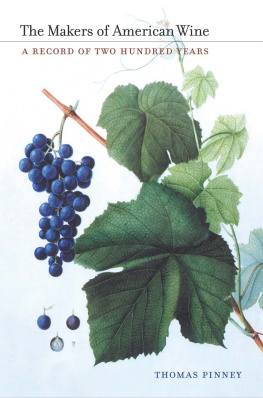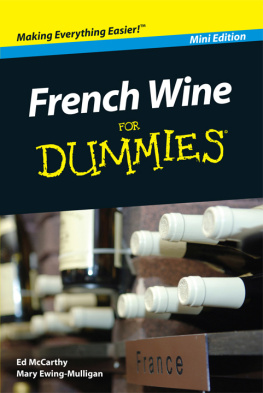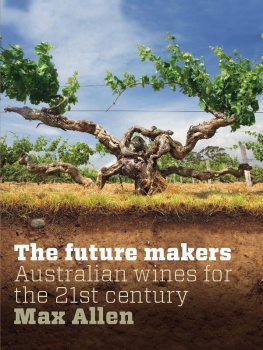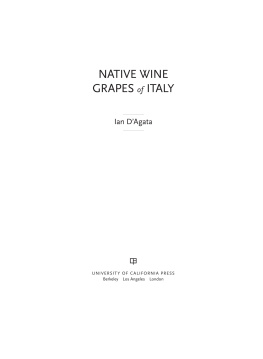The Makers of American Wine
The Makers of American Wine
__________________
A RECORD OF TWO HUNDRED YEARS
Thomas Pinney

UNIVERSITY OF CALIFORNIA PRESS
BERKELEY LOS ANGELES LONDON
University of California Press, one of the most distinguished university presses in the United States, enriches lives around the world by advancing scholarship in the humanities, social sciences, and natural sciences. Its activities are supported by the UC Press Foundation and by philanthropic contributions from individuals and institutions. For more information, visit www.ucpress.edu.
University of California Press
Berkeley and Los Angeles, California
University of California Press, Ltd.
London, England
2012 by The Regents of the University of California
Library of Congress Cataloging-in-Publication Data
Pinney, Thomas.
The makers of American wine : a record of two hundred years / Thomas Pinney.
p. cm.
Includes bibliographical references and index.
ISBN 978-0-520-26953-8 (cloth : alk. paper)
1. ViticulturistsUnited StatesBiography. 2. VintnersUnited StatesBiography. 3. ViticultureUnited StatesHistory. 4. Wine and wine makingUnited StatesHistory. I. Title.
SB387.68.P56 2012
3 81'. 456 6 32dc23 2011035922
Manufactured in the United States of America
20 19 18 17 16 15 14 13 12 11
10 9 8 7 6 5 4 3 2 1
In keeping with a commitment to support environmentally responsible and sustainable printing practices, UC Press has printed this book on Natures Book, a fiber that contains 30% post-consumer waste and meets the minimum requirements of ANSI/NISO Z39.481992 (r 1997) (Permanence of Paper).
To Gail Unzelman
eminent collector, distinguished editor,
generous friend
CONTENTS
ILLUSTRATIONS
ACKNOWLEDGMENTS
The splendid collections of Gail Unzelman, whose generosity is acknowledged in the dedication to this book, were invaluable to me throughout, but particularly for the information they provided for the chapters on Husmann and Morgan. I have leaned heavily on the books of Charles Sullivan, the unrivaled master of American wine history, and have profited from his review of the manuscript. The librarians, without whose willing help no book of this kind can be written, that I would like to thank include in particular Axel Borg, in charge of the Amerine Room, and John Skarstad, in Special Collections, both at the Shields Library, University of California, Davis. Robert Zerkowitz was my guide to the rich archives of the Wine Institute, San Francisco. John Barden, great-grandson of Paul Garrett, and his wife, Polly, generously opened their impressive collection of Garrett memorabilia to me and enabled my account of Garrett by giving me a copy of Garretts unpublished memoir. To all, and to the many unnamed others, my best thanks.
INTRODUCTION
_________
The Makers of American Wine
A RECORD OF TWO HUNDRED YEARS
This book tells the story of American wine through the lives of thirteen peopletwelve men and one womanwho made a difference in that history, or who represent a significant change in the direction of things, or both. The more recent names are probably familiar to all who take an interest in wineMondavi and Gallo certainly arebut other names will be unknown. To give them their deserved recognition is one of my aims in writing this book. I start with Jean Jacques (or John James) Dufour, a Swiss, who did not make the first commercial wine in this country but who made it possible for others to do so. Nicholas Longworth, a man of wealth, used his fortune to produce the first popular American wine; the German immigrant George Husmann became the Johnny Appleseed of the grape, urging every American to plant the vine and make wine. Charles Kohler brought the wine of California to the country at large, and through Andrea Sbarboro the Italians entered into California wine-making, an activity they have seemed to dominate ever since. The era of big business is represented by Percy T. Morgan of the California Wine Association; Paul Garrett showed how wine-growing in the South, the East, and the West could be profitably combined. The others in my select company had equivalent roles to play, as each chapter undertakes to show. In the rest of this introduction I give a summary account of the fortunes of wine in this country to place my subjects in a general scheme.
...
NONE HAD THE LEAST IDEA
OF WHAT A NEW COUNTRY IS
It has been about two hundred years since the first commercial wine was produced in what is now the United States. The exact date is not known, and even if it were, this is an anniversary not likely to be much observed, if it is at all, for our historians write very little about such things. But the fact is that one of the interesting and not insignificant themes of American history is the quest for wine. North America first appears to European awareness as Vinlandthe land of wine. Every one of the early explorers reported that vines abounded in the new country, and every early settlement had wine making as a part of its purpose. The Pilgrims might have had religious freedom as a main motive for their emigration, while the gentlemen of the Virginia Company were simply looking to make money. But both agreed that making wine was one of the first items on their different agendas. The idea was reasonable. North America, as those first explorers saw at once, abounds in wild grapesmore species of grape are found here than in any other region of the world, and it was not just in certain parts of what is now the United States that these grapes were to be found. They were everywhere, north and south, east and west.
Wine-making trials began immediately. And all of them immediately failed. The first trials were naturally made with the native grapes that flourished around every new settlement. But, as was quickly discovered, they were utterly unfit for wine. The European species of grape, named Vitis viniferathe wine-bearing vineby the great Linnaeus himself, has grown for millennia in association with human settlement and, by a long process of selection, has been brought to yield a juice fitted for wine making. The many American species of grapes had grown unrestrainedly in their own wild way. No Native American community made any alcoholic drink from fruit, and wine was as unknown as the horse on this continent. None of the many native American grapes would yield a decent wine: the fruit was too low in sugar, too high in acid, too loaded with strange and unpleasant flavors; typically, the berries were small, with large seeds and meager flesh.
So the early colonists, having at once discovered the defects of the native vines, immediately began to import cuttings of the European grape. This was done over and over again, all up and down the coast of the country, by every sort of settlerPuritan, Pilgrim, Dutchman, Swede, German, Greek, Frenchman, Englishman; by syndicates, by religious communities, by exiled soldiers, by uncounted numbers of scattered individuals. Vinifera cuttings by the tens of thousands were planted on islands, along the riverbanks, among woods, in pastures, and on the slopes of hills, from Maine to Florida. Every single one of these plantings failed, though the effort was renewed again and again. The vines would grow for a time; then they sickened and died. Sometimes they endured long enough to yield a tiny harvest of grapes, but no wine in anything close to commercial quantity was made in this country for two centuries following the beginnings of sustained settlement.










